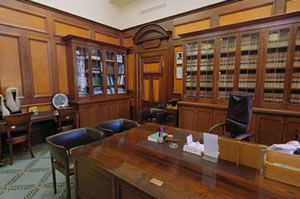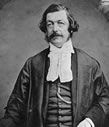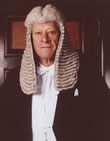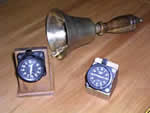House of Representatives: The Speaker
The Speaker's office. View as panorama.
The Speaker, who is elected by MPs, has a key role in representing the House to the Crown and in presiding over the House. The Speaker determines the proceedings of the House and keeps order. The Speaker is also responsible for parliamentary expenditure, chairing the Parliamentary Service Commission, and running the buildings and grounds.
To function effectively in the modern House, the Speaker has to be impartial. This was not always the case in the past, however. In the nineteenth century, the era before party politics, some Speakers were very partisan. In the 1860s, Speaker David Munro, who supported the government, resorted to underhand tactics to get a government bill passed before the session ended ― as the break for dinner approached, he had the clock put back so the bill's final stage could proceed.
This changed once parties were formed. Since the 1890s, the ruling party has usually supplied the Speaker, although once in office, the Speaker is expected to leave party ties behind. Owing to the legalistic nature of the role, many Speakers have been lawyers, and until the 1990s, the Speaker wore a formal wig in the chamber.
One of the Speaker's tasks is to open each day's sitting of the House. A messenger and the Serjeant-at-Arms, carrying the mace, precede the Speaker from the Speaker's office along the corridors of Parliament House and into the debating chamber. The Speaker takes the chair, and then reads the prayer to open proceedings.
See film clip of the swearing in of MPs and election of Speaker Sir Basil Arthur in 1984.
Notable Speakers
The first few decades of New Zealand's Parliament were important and formative times, and the Speaker's role was vital in shaping Parliament. Charles Clifford, elected on 26 May 1854, was the first Speaker, and he remained in the job for the first six years of Parliament's history. His successor, David Munro (1861-70), worked hard to strengthen the Speaker's role in the House. George Maurice O'Rorke (1879 - 90, 1894 - 1902) was a reforming Speaker whose rulings were reportedly adopted in Australia and the British House of Commons. He was also the longest-serving Speaker in the history of the House.
Charles Ernest Statham, elected to the office in 1923, was the first New Zealand-born Speaker. He was keen to see more formality and dignity in the House. The first Speaker from a Labour government was W.E. Barnard, who took up the role in 1936. Peter Tapsell became the first Maori Speaker in 1993, and was also the first Speaker from the Opposition since the 1920s. When Parliament marked 150 years of history in 2004, the Speaker was Jonathan Hunt. He was elected in 1999, 33 years after he became an MP, and he abandoned some of the formality of the role, such as wearing the Speaker's wig.
Learn more about former Speakers on the Speaker's website.
Discipline in the House
The Speaker's authority is backed up by standing orders, which have been revised greatly since 1854. These orders outline the procedures for the sittings of the House and the passage of bills, stipulate what can and cannot be done or said, and indicate the disciplinary action that may be taken against MPs who break the rules.
In the nineteenth century Speakers could fine MPs for disorderly conduct or contempt of the House, but this rarely happened. They could also 'name' MPs and formally record their misconduct. This first occurred in 1887 when MP Julius Vogel made insinuations in the House about the Speaker's drinking habits. The Speaker could also order an MP to leave the House, and the House could pass a motion condemning the MP's actions. These motions were both serious and rare, but being ordered out of the chamber was more common, and MPs did not always take this seriously. In the 1970s and 1980s, an informal 'sin bin' penalty was introduced in which MPs were ordered to leave the chamber for a while to 'cool off' without any further action being taken. Today, if an MP is 'named', the House votes on whether she or he should be suspended from the House for a certain period; if suspended, the MP loses her or his voting rights.
Learn more: Bad language
Speaking rights
New Zealand adopted the British practice of making MPs speak off the cuff or from notes, rather than reading prepared speeches. This rule lasted until 1996 after which MPs could read formal speeches. In practice, Speakers found it hard to enforce the 'no-reading' rule. Many new MPs were terrified at the prospect at speaking only from notes. When the Speaker challenged MPs who looked and sounded as if they were reading, some would deny they were reading a speech by saying 'I am speaking from rather full notes'.
The three types of MP
MP Vincent Pyke, who represented the Dunstan electorate in the 1880s, said there were three kinds of MPs: 'there were the speechless members, who were never heard of except by their votes. Then there were the silly members, who talked nonsense by the yard. And, thirdly, there were the sensible members, who said very little, and said that little to the purpose.'
There was no time limit on speeches in the nineteenth century. A few MPs would speak for hours if they got the chance, and there was little the Speaker could do to stop them. As government business grew, it became clear that speaking time had to be limited otherwise nothing would get done. The time was set at 30 minutes, or an hour for important debates, in 1894. The time got less and less during the twentieth century: 20, 10, then 5 minutes. The Speaker has the job of regulating the time with a clock and a warning bell on his or her desk.
Keeping time
Time is important in the House, and especially for the Speaker who has to monitor the time of speeches during debates. In the early days in Wellington, a large number of clocks had to be wound manually, and regularly. Between the 1920s and the 1950s, a Post Office technician set the 'master' clock and synchronised 'slave' magnetic clocks. But no two clocks seemed ever to show the same time and MPs could use this as an excuse for being late into the chamber. The time-setting service ceased in the 1950s and new, more accurate clocks were installed in the early 1960s.
Dressing down
Among the Speaker's many duties was ensuring that MPs came into the House dressed appropriately. This was more complex than it sounds, for Parliament had rules about jackets, ties, hats, and when they could and could not be worn.
An old British House of Commons custom forbade MPs from wearing hats when entering or leaving the chamber or when addressing the House (although they were generally worn in the chamber at other times). The rule that MPs had to rise and take their hats off as messages from the Governor were read had them bobbing up and down like jacks-in-the-box in the early days. The standing orders of 1865 specified that if a member wanted to speak (usually to a point of order) after the doors had been locked for a division, he had to do so from a seated position and with his hat on. Some MPs had to scramble desperately for a hat, anyone's, whether it fitted or not. The custom persisted into the 1960s.
By that time, some MPs were protesting about the stuffy dress code. At a time when many men wore their hair long and coloured shirts were all the rage, MPs Bob Tizard and Warren Freer launched a 'jackets off' campaign. In the warmer weather, Opposition MPs defied the Speaker by removing their jackets, donning them again only under dire threats of suspension from the House. Tizard rubbed it in by wearing a garish orange towelling hat right under the Speaker's nose. But the Speaker stood firm and Parliament's formal dress code remained.
In the 1980s in summer sittings the rule on the wearing of jackets was relaxed but ties stayed. In 1993 Speaker Peter Tapsell ordered the jackets back on. Men must still wear jackets and ties, though Rastafarian MP Nandor Tanczos wore his heart on his sleeve in a suit specially made of 'hemp' fabric.
External link
The Speaker's website includes more information on the Speaker's role.
Next: Members of Parliament >




